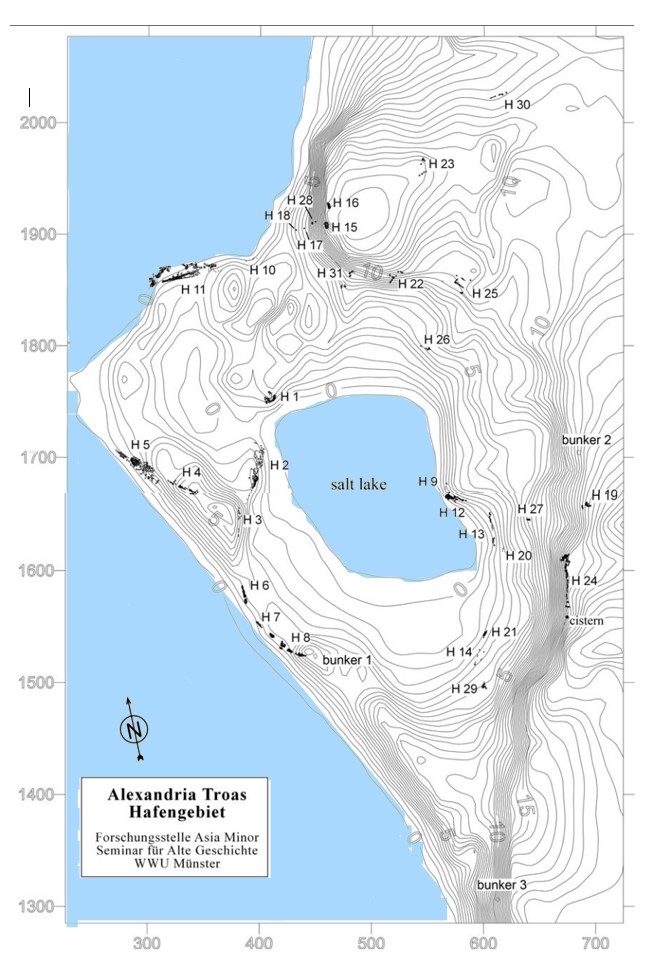
Alexandria Troas – Ancient site | No labels | Troas harbor
Assos – Overview | Close-up | Acropolis
Zoom out to Cities of Paul near the Hellespont
Zoom way out to Biblical cities of Turkey (Asia Minor)
Zoom way, way out to “Lands of the Eastern Mediterranean”
Paul’s Second Missionary Journey
Paul’s Third Missionary Journey
Because of the constant and heavy traffic moving in and out of the Dardanelles to and from the Black Sea, merchants had a strong need for a good harbor near the southern entrance. The strong southerly current, the prevailing wind out of the north, and the square-rigging of the vessels, which prevented tacking more than seven points into the wind, made it necessary for many ships to linger near the entrance before venturing into the straits.
To meet this need, citizens of Troas created an artificial harbor by scooping out a basin about 400 m. in diameter, supplemented by a smaller basin at the entrance. These they protected with two breakwaters, one to the north and one to the south of the entrance they created. The resulting harbor was of medium size by ancient standards but adequate for the needs of the vessels frequenting the sea lanes of the Dardanelles.
Archaeologists have explored the structures surrounding what is left of the artificial harbor, including the underwater remains of the extensive breakwaters and the above-ground quays, walls, and channels remaining to the present day. In addition, they found three stone bunkers, which they believe were probably constructed in anticipation of the outbreak of World War I.
The Apostle Paul first visited Troas around the year 50 CE near the beginning of his Second Missionary Journey. While at Troas, Paul had a vision of a man pleading with him, “Come over into Macedonia and help us.” Responding to this vision, Paul launched his missionary efforts in the continent of Europe. This is recorded in Acts 16:8-10.
During Paul’s Third Missionary Journey, in about the year 56, Paul returned to Troas because God had opened the door for the gospel to flourish there (2 Cor. 2:12-13). He returned to Troas once again at the close of the Third Journey, around 59, where he broke bread with Christians there and preached until midnight. A young boy nodded off during the prolonged sermon and fell to his death out of the third-storey window. Paul raised him from the dead, and then continued speaking until morning (Acts 20:7-12).
After the Emperor Constantine chose Byzantium over Troas as the new capital of the empire (330 CE), the importance of Troas went into steady decline.
Excavations at Troas, ongoing since 1993, are conducted as a collaborative effort between Ankara University, Çanakkale University, and the University of Muenster. Despite the looting of the site in the 17th C. CE down to the foundations of many of its buildings, the archaeological team has uncovered and explored the circular courtyard gate, forum temple, colonnaded street, podium hall, polygonal building, stadium, lower agora, theater, odeum, central baths, nymphaeum, buildings of Herodes Atticus (its 2nd C. CE Athenian benefactor), aqueducts, the sewer system, and the artificial harbor. Professor Erhan Öztepe of Ankara University is the current excavation director.
Want to Dive Deeper?
The following are recommended to help you look deeper into the history and archaeology of Alexandria Troas.
Recommended for purchase:
- CD-ROM: Turkey: Pictorial Library of Bible Lands (2004)
- Marijana Ricl – The Inscriptions of Alexandria Troas (Österreichische Akademie der Wissenschaften, Habelt, 1997).
- Haberin Devami – “Architectural Details of Ancient City Uncovered” (09/20/2019).
- Claude E. Fant and Mitchell G. Reddish – A Guide to Biblical Sites in Greece and Turkey (Oxford, 2003). Excerpt
- Mark Wilson. Biblical Turkey: A Guide to the Jewish and Christian Sites of Asia Minor. Revised ed. Istanbul: Ege Yayinarli, 2020.
Online resources:
- Stefan Feuser. “The Roman Harbour of Alexandria Troas, Turkey.” International Journal of Nautical Archaeology 40, 2 (2011): 256-273.
- C. J. Hemer. “Alexandria Troas.” Tyndale Bulletin 26, 1 (May 10, 1975): 79-112.
- Robert Jewett. “The Troas Project: Investigating Maritime and Land Routes to Clarify the Role of Alexandria Troas in Commerce and Religion.” (May 2005)
- Grabund in Alexandria Troas” (in German, translation: “Excavations in Alexandria Troas”). Institut für Klassische Archäologie und Frühchristliche Archäologie der Westfälischen Wilhelms-Universität Münster. See especially, “Hafen.”
